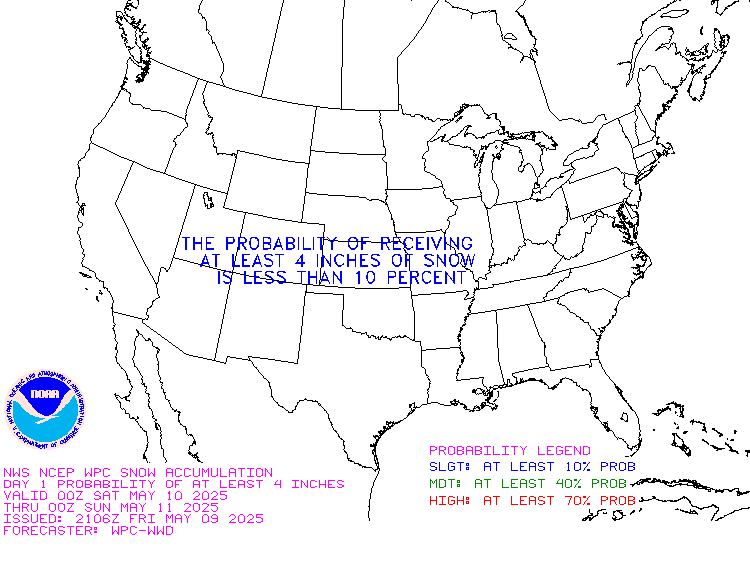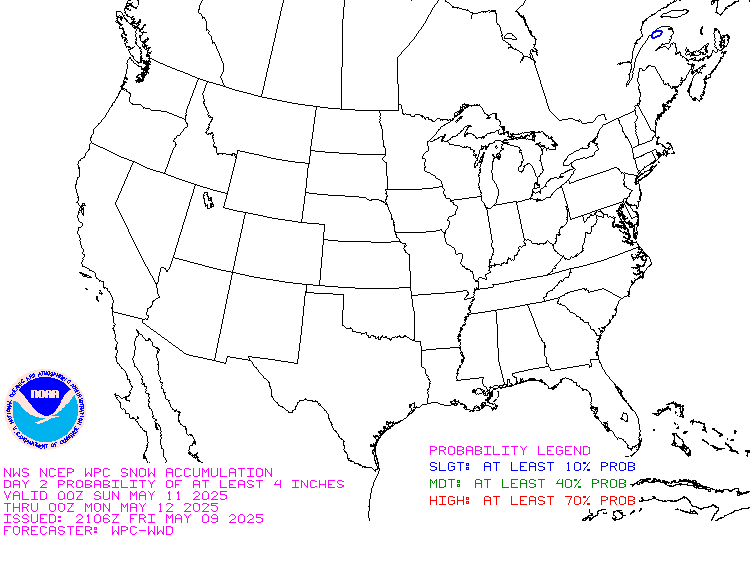It is difficult to find a more comprehensive Weather Outlook anywhere else with the ability to get a local 10-day Forecast also.
This article focuses on what we are paying attention to in the next 48 to 72 hours. The article also includes weather maps for longer-term U.S. outlooks and a six-day World weather outlook which can be very useful for travelers.
First the NWS Short Range Forecast. The afternoon NWS text update can be found here but it is unlikely to have changed very much. The images in this article automatically update.
Short Range Forecast Discussion
NWS Weather Prediction Center College Park MD
Thu Mar 07 2024
Valid 12Z Thu Mar 07 2024 – 12Z Sat Mar 09 2024…Storm system to bring the threat of flash flooding and severe weather
to the Southern Plains Thursday, spreading eastward into the Lower
Mississippi Valley and Southeast Friday……Areas of moderate to heavy snow expected for the Central Rockies/High
Plains Thursday……Another Critical Risk of Fire Weather Thursday for the Southern High
Plains……High temperatures remain above average and Spring-like for the eastern
U.S. with below average temperatures in the West…A complex weather system evolving over the central U.S. will bring showers
and thunderstorms with the threat of severe weather and flash flooding to
the Southern Plains/Southeast, a risk of wildfires in the High Plains, and
some areas of heavy snow over the Rockies/Central High Plains over the
next couple of days. Upper-level troughing approaching from the west will
help to deepen/organize a low pressure/frontal system over the Southern
Plains, further reinforced by a Pacific system moving in from the West.
Southerly moist Gulf return flow ahead of a sharpening dryline will bring
increasing shower and thunderstorm chances to the Southern Plains
beginning as early as Thursday morning. Increasing deep-layer shear with
the approach of the upper-level trough as well as sufficient CAPE will
bring the threat for a few severe thunderstorms, and the Storm Prediction
Center has highlighted central Texas and western Oklahoma/south-central
Kansas with Slight Risks of Severe Weather (level 2/5) for some instances
of large hail along with damaging winds and an isolated tornado. In
addition, the increasing moisture will lead to some heavier downpours, and
the threat for a couple rounds of storms evolving downstream over north
Texas Thursday evening has prompted a Slight Risk of Excessive Rainfall
(level 2/4) for some scattered instances of flash flooding, particularly
for urban areas in the DFW metroplex. Very dry conditions will exist west
of the dryline over the Southern High Plains, which when combined with
warm temperatures and gusty winds has prompted a Critical Risk of Fire
Weather (level 2/3) form the Storm Prediction Center. To the northwest, a
secondary frontal system pushing southward will bring much colder air into
the Central Rockies/High Plains. Areas of moderate to heavy snow are
expected to continue through the day Thursday for portions of the Central
Rockies, particularly along the Front Range in Colorado. In addition,
confidence has increased in a round of snow bands moving through portions
of northeastern Colorado into western Nebraska bringing heavy snow rates
of 1-2″+ per hour and several inches of accumulating snow, with Winter
Storm Warnings now in effect. The snow should come to an end for the High
Plains into Friday morning, with chances in the mountains shifting
southward into the Southern Rockies.The system will continue eastward Friday, with an expanding area of shower
and thunderstorms spreading into the Midwest, Lower Mississippi Valley,
and Southeast. A reinforcing influx of more anomalous moisture flowing
northward with a warm front from the Gulf will bring a higher threat for
more widespread heavy downpours compared to Thursday, with the expectation
that clusters of storms will bring repeated rounds of rainfall along the
frontal boundary into Friday night. A Moderate Risk of Excessive Rainfall
(level 3/4) has been introduced from east-central Alabama into northern
Georgia where wet antecedent conditions from the night before will further
help increase the threat for some scattered to numerous instances of flash
flooding, particularly for urban areas in the greater Atlanta region. A
broader Slight Risk is in place from the Lower Mississippi Valley eastward
through the Southern Appalachians. Another round of severe weather is also
expected, with a Slight Risk of Severe Weather stretching from eastern
Texas/southeastern Oklahoma through the Lower Mississippi Valley and
towards the central Gulf Coast. Large hail, damaging winds, and a few
tornadoes are all possible.Elsewhere, the noted Pacific system eventually reaching the Plains will
first move eastward from California into the Great Basin/Southwest on
Thursday, with some light to moderate rain/snow showers for the Great
Basin and a few thunderstorms in the deserts of the Southwest. Some light
to moderate showers will taper off through the day Thursday in southern
New England as a frontal system departs the region, with the potential a
bit of snow may mix in. Some additional light snowfall accumulations will
be possible further north into Maine. Showers and thunderstorms will also
continue in South Florida Thursday ahead of a cold front. Finally, an
approaching Pacific system will bring increasing precipitation chances to
the Pacific Northwest later Thursday and into Friday morning.Temperature wise, highs will remain above average for much of the eastern
U.S. ahead of the frontal systems approaching from the west over the
Plains. Highs will range from the 40s and 50s in the Upper Midwest east
through the Great Lakes and New England; the 50s and 60s from the Middle
Mississippi Valley east through the Ohio Valley and into the Mid-Atlantic;
and the 60s and 70s from the Lower Mississippi Valley into the Southeast.
Portions of the Central/Southern Plains will be above average Thursday,
with highs in the 50s and 60s in the Central Plains and 70s and 80s in the
Southern Plains. Cold fronts passing through with the central U.S. system
will bring some much cooler temperatures Friday, with highs dropping to
the 40s and 50s for western portions of the Plains. The Northern Plains
will recover Friday following a chilly day Thursday, with highs in the 20s
and low 30s rising into the upper 30s and 40s. Temperatures will generally
remain below average in the West, with 30s and 40s for the Pacific
Northwest and Great Basin, 50s and 60s for California, and 60s and 70s
into the Southwest.
To get your local forecast plus active alerts and warnings click HERE and enter your city, state or zip code.
Above is a 72 hour animation of the forecast. Learn about wave patterns HERE.
Then, looking at the world and of course, the U.S. shows here also. Today we are looking at precipitation.
Please click on “Read More” below to access the full Daily Report issued today.
| Notices: What would you like to learn about? Please provide that to me via the comment section at the end of the article. |
Now more detail on the 48-Hour Forecast (It is a 48 to 72 Hour Forecast actually)
Daily weather maps. The Day 1 map updates twice a day and the Day 2 and 3 maps update only once a day. These maps update automatically. But if that does not happen, you can get updates by clicking HERE
TODAY (or late in the day the evening/overnight map will appear) (Key to surface fronts shown on maps and you will then also be able to insert a city name or zip code and get a local NWS forecast).
TOMORROW
NEXT DAY
This animation shows how things may play out over the next 60 hours. To update click here.
The NWS Climate Prediction Center’s: Watches, Warnings, and Advisories plus other information can be found HERE. We post at least one of those updates daily, sometimes both. The Highlights are shown in the lede paragraph of this article.
ATMOSPHERIC RIVERS
This tells us what is approaching the West Coast. Click HERE to update If I have not gotten around to doing the update. Here is some useful information about Atmospheric Rivers.
Below is the current five-day cumulative forecast of precipitation (Updates can be found HERE)
Ski SnowReports
New Feature – Ski Reports. It is difficult to find reports that auto-update on-screen (and they are very long) but these links will get you to them – If you have additional suggestions make them in the comments section after every Econcurrents Article and we may add those links. We will try to not have too much overlap as that can add to the confusion.
Snow Forecasts. And remember this shows natural snow. Ski resorts also make their own snow.
Day 1

Day 2

Additional snow information can be found here, here, here, and here. The second link provides animations.
Now we look at Intermediate-Term “Outlook” maps for three time periods. Days 6 – 10, Days 8 – 14, and Weeks 3 and 4. An outlook differs from a forecast based on how NOAA uses these terms in that an “outlook” presents information as deviation from normal and the likelihood of these deviations.
Below are the links to obtain updates and additional information. They are particularly useful if you happen to be reading this article significantly later than when it was published. I always try to provide readers with the source of the information in my articles. These links may also be useful for those viewing this article on a cell phone or other small screen.
| Days 6 – 10 (shown in Row 1) | Days 8 – 14 (Shown in Row 2) | Weeks 3 and 4 (Shown in Row 3 but updates only on Fridays) |
| https://www.cpc.ncep.noaa. gov/products/predictions/610day/ | https://www.cpc.ncep .noaa.gov/products/predictions/814day/ | https://www.cpc.ncep.noaa.gov/products/predictions/WK34/ |
Showing the actual maps. They should now update automatically. The Week 3 – 4 Outlook only updates on Fridays. So below is what I call the Intermediate-term outlook. On Fridays, it extends out 28 Days. That declines day by day so on Thursday it only looks out 22 days until the next day when the Week 3 – 4 Outlook is updated and this extends the outlook by one additional week.
| 6–
10
|
|
|
| 8–
14 |
|
|
| 3–
4 |
|
|
HAZARDS OUTLOOKS
Click here for the latest complete Day 3 -7 Hazards forecast which updates only on weekdays. Once a week probably Monday or Tuesday I will update the images. I provided the link for readers to get daily updates on weekdays. Use your own judgment to decide if you need to update these images. I update almost all the images Friday Night for the weekend edition of this Weather Report. So normally readers do not need to update these images but if the weather is changing quickly you may want to.
Temperature month to date can be found at https://hprcc.unl.edu/products/maps/acis/MonthTDeptUS.png
Precipitation month to date can be found at https://hprcc.unl.edu/products/maps/acis /MonthPNormUS.png
World Forecast [that website is has been intermittent so be patient]
Below are the Day 1 -3 and 4-6 forecasts for temperature and precipitation. Updates and much additional information can be obtained HERE
World Temperature Anomalies
World Accumulated Precipitation
This information is provided by the University of Maine. They draw upon many different sources. There is a lot of information available at the link provided. I have just provided two useful forecasts. There are probably over a hundred different forecasts available from this source.
Worldwide Tropical Forecast (This is a NOAA Product)
This graphic updates on Tuesdays) If it has not been updated, you can get the update by clicking here Readers will only have to do that if they are reading this article much later than the date of it being published.
Information on Tropical Storms can be found HERE. Western Pacific information can be found HERE.
–
| I hope you found this article interesting and useful. |
–
